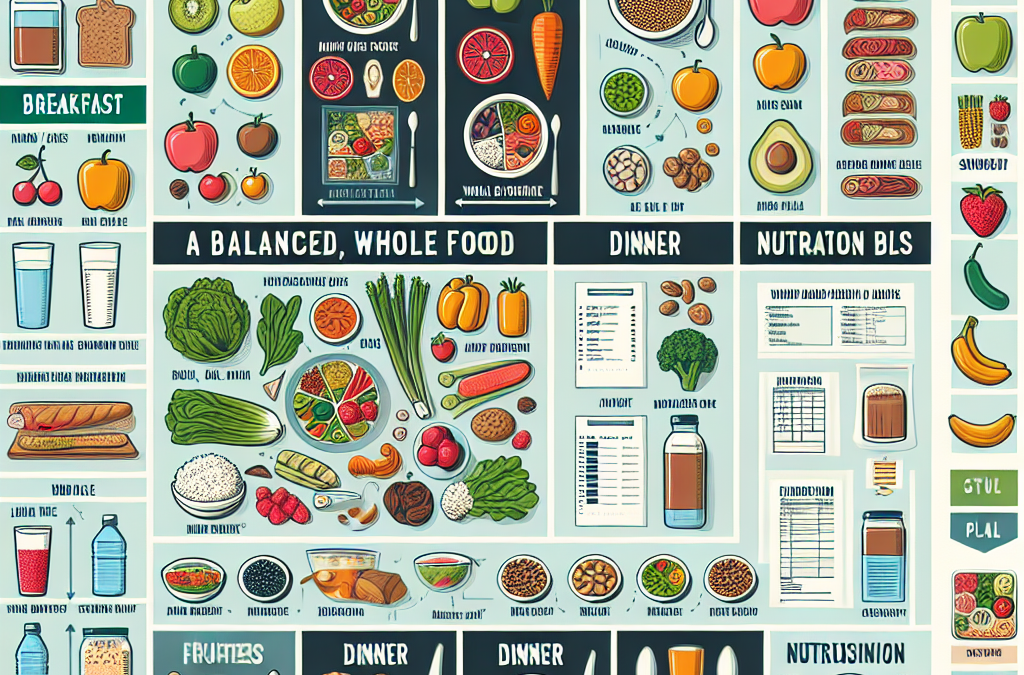Understanding Whole Foods
What Are Whole Foods?
Whole foods are basically foods that are as close to their natural state as possible. Think fruits, veggies, nuts, seeds, and whole grains. No crazy additives, no mystery ingredients – just pure, wholesome food. The beauty of whole foods is that they’re rich in nutrients and help keep your body functioning at its best.
When I made the switch to a whole food diet, it opened my eyes to just how many options I had. Instead of relying on pre-packaged meals and snacks, I discovered the joy of cooking with fresh ingredients. Plus, knowing what you’re eating can feel pretty empowering.
It’s a bit of a mindset shift, but once you get the hang of it, choosing whole foods becomes a natural part of your daily routine. For me, it turned into a fun challenge – how can I make this dish from scratch using whole ingredients? It encouraged creativity in the kitchen, and it also reassured me that I was taking care of my health.
The Benefits of Whole Foods
Eating whole foods can have a ton of benefits that go beyond just nutrition. For starters, they can help boost your energy levels, stabilize your blood sugar, and even enhance your mood. It’s fascinating to see how my body responded positively to these types of foods. Instead of feeling sluggish after meals, I found myself feeling energized and ready to tackle the day.
Another big perk? Whole foods can help manage weight effectively. Because they’re nutrient-dense, they often fill you up more than processed foods do, making it easier to stick to healthy portions without feeling deprived. I noticed that I was snacking less and feeling satisfied after meals, which was pretty incredible.
Lastly, let’s not forget about the environmental impact! Whole foods often come with less packaging, and choosing organic or locally-sourced options can greatly contribute to sustainability. Every small step I took toward a whole food lifestyle felt like I was also doing my part for the planet.
How to Integrate Whole Foods into Your Diet
Integrating whole foods into my daily life was easier than I thought. I started by making small swaps – replacing white bread with whole grain, for instance. These little changes quickly added up. Soon, I was exploring new recipes and trying out seasonal produce from my local farmers market.
Meal prepping was a game-changer for me. I’d set aside Sundays to wash, chop, and prepare my meals for the week. Not only did it save me time, but it also made it way harder to fall back on takeout or processed foods when I was busy. Having jars of colorful salads or stir-fry veggies in my fridge waiting for me was a delightful convenience!
Lastly, experimenting with different cuisines enriched my whole food adventures. I discovered how many international dishes were naturally centered around fresh, whole ingredients. I tried my hand at Mediterranean flavors, which emphasized whole grains, olives, and fresh veggies – so delicious and satisfying!
Planning Your Whole Food Meal Plan
Start with a Template
When I first began planning my whole food meals, I found it helpful to create a simple template. I broke my meals down into categories: breakfast, lunch, dinner, and snacks. This way, I knew I could incorporate various whole foods without feeling overwhelmed.
A typical breakfast for me became oatmeal topped with fresh fruit and seeds. Lunch was often a big salad with leftovers from dinner or a hearty grain bowl. Dinner? I’d whip up a vegetable stir-fry or a roasted veggie plate with some protein. And snacks? Hummus with veggies or a handful of nuts were my go-to.
Having this kind of structure made grocery shopping way easier too. When I have a solid plan, it’s like I walk into the store knowing exactly what to grab, which cuts down on impulse buys of less healthy options. It’s all about setting yourself up for success!
Incorporate Seasonal Produce
One of the best pieces of advice I can give you is to eat with the season. Seasonal produce is often fresher, tastier, and more affordable. I started making it a habit to check what fruits and vegetables are in season each month, and it transformed my shopping list.
When you eat seasonally, it inspires creativity in your cooking. I remember one summer, I went a little crazy with an abundance of zucchini. I made zucchini noodles, added it to stir-fries, and even tried baking zucchini bread! There’s nothing quite like the flavor of freshly picked produce.
Plus, seasonal eating connects you to your local community and supports small farmers. It’s a win-win situation that makes my whole food journey even more fulfilling. It’s not just about the food I’m eating; it’s about the story behind it too.
Batch Cooking and Freezing Meals
Batch cooking has been a lifesaver for me, especially on busy weeks. I set aside a few hours every week to prepare a larger amount of food that I can easily grab throughout the week. Soups, stews, and casseroles are perfect for this – they freeze wonderfully!
When you batch cook, not only do you save time during the hectic weekdays, but you also reduce food waste. If I find veggies that are about to go bad, they often get added to a pot of soup or a stir-fry, and voila! I’ve created something delicious and nutritious without having to toss anything out.
Freezing meals has made it easy to always have a nutritious option on hand. I’ve had nights when I just didn’t feel like cooking, and being able to pull out a homemade lasagna or a veggie curry from the freezer saved the day. It’s amazing how that little bit of prep work can lead to so much convenience down the line.
Creating Balance and Variety
A Balanced Plate
When it comes to meals, balance is key. I learned to fill my plate with a variety of whole foods to ensure I’m getting a range of nutrients. It’s not just about choosing healthy foods, but also about creating meals that are diverse in texture, flavor, and color.
I often think of my plate as a palette; the more colors I incorporate, the healthier it usually is. Bright greens from leafy veggies, oranges from sweet potatoes, and a pop of purple from beets all end up on my plate. Each color signifies different vitamins and minerals – so neat, right?
Finding a balance between different food groups – protein, fats, and carbohydrates – has been crucial too. I love experimenting with plant-based proteins like lentils and chickpeas, while also including healthy fats from avocados and olive oil. It’s all about creating a harmonious meal that fuels my body effectively, leaving me satisfied and energized.
Get an Amazing Discount on Best Organic SuperFood Product!
Exploring New Recipes
Exploring new recipes has kept my whole food journey exciting and fun. There’s a whole world of flavors out there! I’ve gathered inspiration from cookbooks, food blogs, and social media, giving me tons of ideas to keep my meals fresh.
Every week, I try to pick a new recipe that incorporates ingredients I might not usually reach for. This has expanded my horizons tremendously! From discovering new grains like quinoa to trying out unusual fruits like dragon fruit, my cooking adventures have never been boring.
Cooking can be a creative outlet too. I find so much joy in experimenting with spices and flavors – it feels great to work with my hands and create something nourishing. Plus, I’ve introduced my friends to some of these recipes, and sharing the experience made it even more special!
Listening to Your Body’s Needs
One of the most important lessons I’ve learned throughout this process is to listen to my body. Some days, I crave lighter meals full of veggies, while other days, I might want something hearty and filling. Being attuned to what my body needs has dramatically changed my relationship with food.
Taking the time to understand my hunger cues has made my meals far more satisfying. Instead of sticking to strictly scheduled meal times, I now pay attention to when I feel hungry or full. It’s about tuning into the signals my body gives me and responding with the right whole foods at the right times.
This shift in mindset has ultimately made me enjoy food even more. It’s not just about fueling my body; it’s about savoring flavors and enjoying every bite. Meal times have become moments of mindfulness rather than rushed obligations, and let me tell you, that’s a game changer!
Staying Motivated and Inspired
Setting Realistic Goals
Setting realistic goals plays a huge part in staying motivated on this journey. Instead of overwhelming myself with aggressive goals (like committing to a strict diet), I focused on attainable changes I could make over time. This made the entire process feel much more enjoyable and sustainable.
For example, rather than saying I’d only eat whole foods from day one, I aimed to make at least one meal a day whole food-based. This small shift made a big difference and allowed me to enjoy the process while tracking my progress.
No matter how small they are, celebrating your wins keeps you motivated! Whether it’s trying a new recipe or successfully meal prepping for a week, acknowledge that you’re making strides toward a healthier lifestyle.
Finding Support
Having a support system is crucial when making lifestyle changes. I started sharing my journey with friends and family, and it was amazing to see how many supportive voices I found! Some of my friends even joined me in this whole food adventure. We’d share recipes, tips, and even cook together, making it a fun bonding experience.
Online communities can also be a fantastic resource. I found several groups on social media where people share their experiences, recipes, and encouragement. It’s encouraging to see others on a similar path – it reminds me that I’m not alone in this journey.
Joining cooking classes or workshops can also be an excellent way to meet like-minded individuals and learn more about whole foods in a fun, engaging environment. It’s all about building that supportive network!
Keeping Things Fresh
Lastly, keep things fresh and exciting! Eating the same meals can get monotonous, so I make it a point to switch up my ingredients and try new methods of preparation regularly. For instance, I may steam, roast, or grill the same vegetable, and each method brings out a different flavor profile.
I also enjoy themes for certain days of the week, like Meatless Monday or Taco Tuesday. It encourages me to get creative about how I can feature whole foods around these themes, infusing variety into my meals while still leading a wholesome lifestyle.
Stay curious! Whenever I visit the grocery store, I look for unfamiliar ingredients or seasonal items and try to include them in my meals. This keeps the culinary adventure alive, and there’s always something new to look forward to!
Frequently Asked Questions
1. What are whole foods, and why should I eat them?
Whole foods are foods that are minimally processed and remain as close to their natural state as possible. They offer numerous health benefits, such as improved energy levels, better digestion, and enhanced overall well-being.
2. How do I create a whole food meal plan?
Start by understanding what whole foods are and then outline your meals. Consider making a template for breakfast, lunch, dinner, and snacks, focusing on incorporating a variety of whole foods for balance and nutrition.
3. Is it complicated to switch to whole foods?
Not at all! Start with small changes, like replacing processed snacks with fruits or nuts, and gradually incorporate more whole foods into your diet. It’s all about taking it one step at a time.
4. How do I stay motivated to eat whole foods?
Set realistic goals, find a support group, and keep your meals exciting! Explore new recipes and try out seasonal ingredients to keep your motivation high and your meals interesting.
5. What should I do if I feel overwhelmed with meal prep?
Take a deep breath and remember, it’s okay to start small. Try to meal prep for just a couple of meals at first. Gradually build your confidence and skills from there, and remember to have fun with it!




